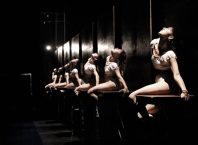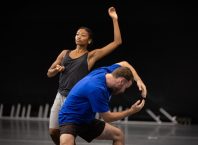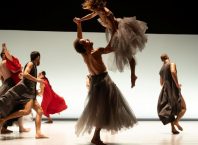Curtain Up 2016 was marked by its diversity, and the sure-footed confidence and prowess of its 10 choreographers and many performers. The diversity is representative of contemporary dance today, which almost resists definition in its infinite variety, and the blurring of lines between dance and performance. Contributing to the sense of diversity is the independent selection of the choreographers by two artistic directors: Itzik Giuli and Hillel Kogan. While I did not relate in the same manner to every work (taking into account preferences and biases*), I felt that the choreographers, each with his or her individual approach and perspective, worked from a place of proficiency and precision. Curtain Up presented a spectrum of mature practitioners, with an internal harmony to each curtain, revealing different aspects of the current Israeli dance scene.
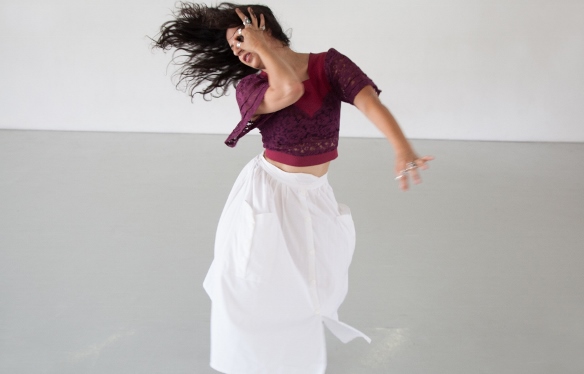
Pirg’in by Sahar Damoni, in Curtain Four, was the first work I saw and it provided an inviting entry point to the festival. In this compact and intense solo, the soundtrack of Arab male voices in different contexts plays a significant role, a counterpoint to the female dancer (Damoni), clad in symbolic white. With footwork that evokes the step of a folk dance, Damoni turns and circles incessantly, embodying the sense of a vicious cycle, a body caught in the prescribed steps of tradition, surrounded by the voices of men. Yet there was also an expressive freedom in her movement language, at once in step and divergent from tradition, a body that speaks in its individual voice.
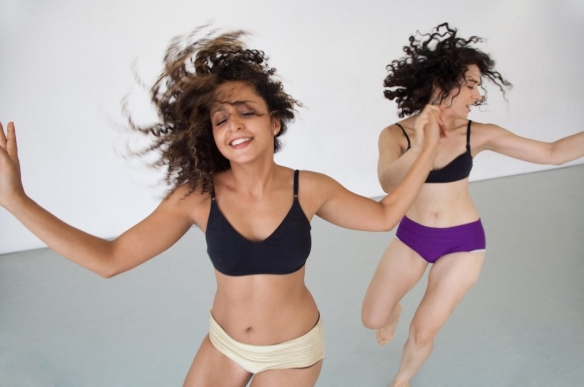
Rising by Shira Eviatar, performed by the choreographer with Anat Amrani, is a vivacious meditation on the traditional dances of Yemen and Morocco. Distilling the movement language of the two traditions, through the filter of a contemporary gaze with appreciation and humor, the work begins without the accompaniment of music, focusing the viewer on the minutiae of gesture, beginning in the origin of all origins: the pelvis and hips. A joyous exuberance emanates from the ebullient dynamic between the two dancers, the bouncing curls and vibrating hips. There is a synergy between Damon’s and Eviatar’s pieces, in their relationship to tradition and the Sisyphean intensity of these works. The intervals of music in Eviatar’s work heighten the ecstatic effect of the dance, while the intervals without added soundtrack emphasize the body as instrument: the stamp of the feet, the clapping hands, the breath, the celebratory ululation a dance of the tongue.
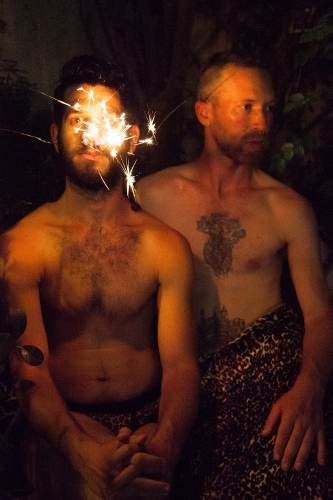
Asaf Aharonson’s What’s To Come presented alluring and intriguing vignettes, many imbued with humor, yet ultimately felt too diffuse, dissipating its initial energy.
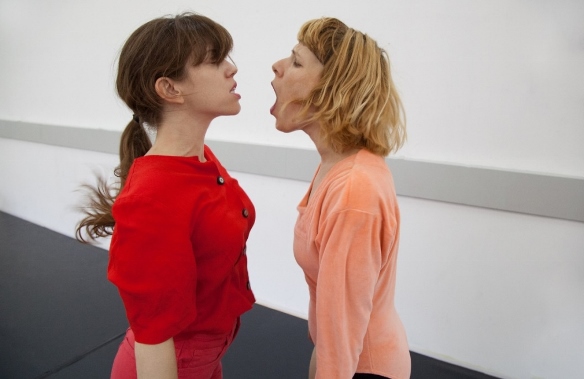
Merav Dagan and Stav Marin, two scintillating, expressive and intelligent performers, collaborated on the duet Come Closer (Curtain Three), a mesmerizing rapid-fire succession of allusive movement and gesture, meticulous, precise and wildly entertaining. It’s a challenge to the senses to meet the pace of this work’s imagery, a kinetic reflection on the mythology of woman, generating a multitude of associations. Opening with a very brief yet explicit entrance into character, announcing the fictional quality of all that is about to transpire, a fit of weeping overtakes their bodies, quaking, heaving, shaking and shuddering. Emitting utterances that sound like words yet are not, their gestures – kneeling, hands held behind the back, hand on mouth – signify a body to which things are being done. They stand, face to face, the sounds and gestures become a conversation, an argument, amusing in its exaggeration as the gesticulate in an explanatory manner, appealing to the audience. A commiserating pat on the head, rhythmic, repeated, mutates into a sexual thrusting, and then the cuddling, embracing gestures metamorphose into something that references dance. Words emerge from the constant babble of sound: yalla, come, there. Hips slowly gyrate, a whistle. Stav Marin in her hooded short onesie does a sexy dance, while Merav Dagan, clad in a T shirt emblazoned with a black bra on the back, prances and pouts like a little girl, then is all street cool, speaking in hip hop. Onstage is a green tangle of leaves and vines, at the other side, at the back, is a large rock. Drowning and tangled in leaves, these women appear to save and console one another, then crawl to the rock, dragging a trail of green. Seated on the rock, these mermaids, these sirens, softly, then loud and boldly, sing their song. One cannot help but be drawn in.
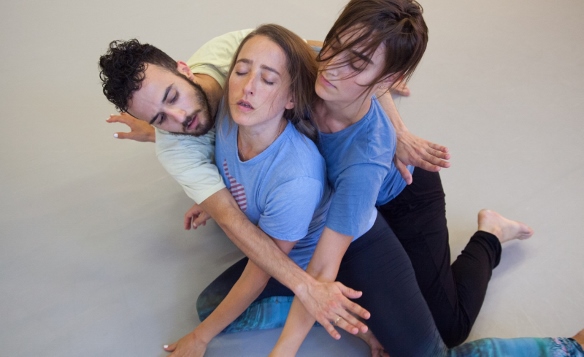
Nadar Rosano works with a dystopian feel in Behind the Mountain, as Stav Struz, Roni Brandshtater and Zuki Ringart move through a dark space. Ladders lying on their sides, one appearing semi-submerged in the floor, suggest fallen towers, an urban ruin, the collapse of human effort. The three dancers express an isolation and alienation that is only accentuated by those moments when they connect.
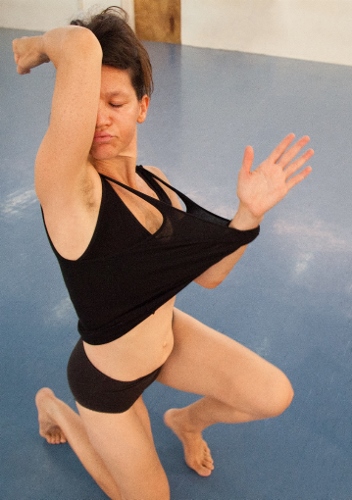
I approached The Chicken Memorial, Michal Samama’s piece in Curtain One, with a great deal of curiosity, having never seen her work before. Samama stood at a podium as the audience entered, greeting the people who entered with the prescribed script for a professional gathering, town meeting, or other community events: Welcome, thank you for coming, please take your seat. While intrigued by the opening, and on hyper-alert, noting each word and gesture, ultimately, the performance felt opaque to me and I was not able to enter imaginatively into Samama’s world. *Now is the time to recall my previous aside regarding preferences and bias. When relating to art I have a strong preference for those works that communicate through the senses, working in a direct and immediate manner. Furthermore, I must confess to a slight bias towards the appeal to the emotions rather than the intellect. While reading the text accompanying Samama’s work (in the program) would help elucidate the significance of the words and gestures perceived, the experience of The Chicken Memorial felt like hard work, without yielding understanding.
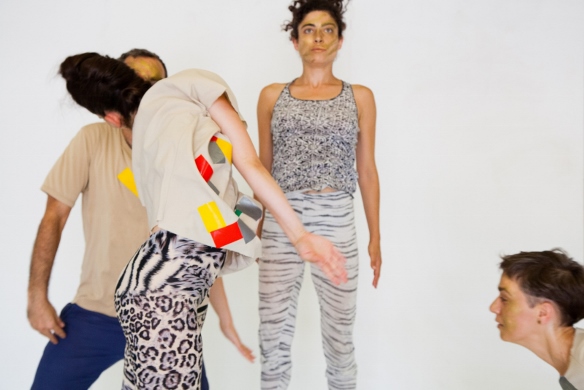
Next up in this Curtain was The Calling, by Tami Lebovits, which opened in a very intriguing and unconventional manner, with the members of the cast – Or Avishay, Or Ashkenazi, Maya Weinberg, Moshe Shechter Avshalom, Tami Lebovits – singing a capella from the balcony of the Suzanne Dellal auditorium. The musical motif recurs in different forms and fragmentations, as the dancers combine, separate and recombine in different configurations. There was a slow intensity to this work that given my admitted exhaustion following Samama’s piece, was probably not a felicitous chronology, preventing my fully connecting. Yet the expressive abilities of the performers did elicit sparks, and possibly hallucinatory moments, as when their slow walk and finger snapping rhythm conjured an image of “West Side Story – the zombie version.”
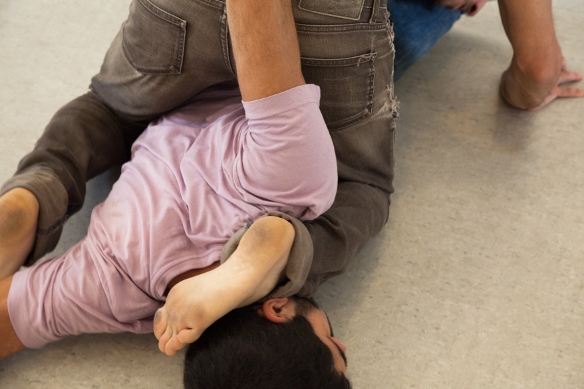
Curtain Two concluded my festival experience in celebratory mode, I walked out of Suzanne Dellal last night feeling euphoric after seeing works by Adi Boutrous and Andrea Costanzo Martini. Boutrous has a fluid, acrobatic movement language, an understated grace with underlying tensile strength. It’s Always Here is a duet performed by Boutrous with Avshalom Latucha, both eloquent dancers in a work of intense physicality. Accentuating the similarities and differences between the two, they move apart and in unison, approaching, connecting and confronting, struggling, wrestling with one another. Head to head, moving entangled, self and other merge and separate, evoking associations of an inner conflict that is perhaps no less potent than external conflict. Literally standing on their heads, the dancers suggest an alternate way of seeing the world, an alternate way of being in the world. Covering vast expanses of stage in backwards somersaults, rhythmic waves of soft undulation, feats of endurance, inscribing delicate circles on the air, the movement language is varied, expressive and always alluring. There is a beautiful freedom to the movement, with a perfect soundtrack that flows between music and silence.
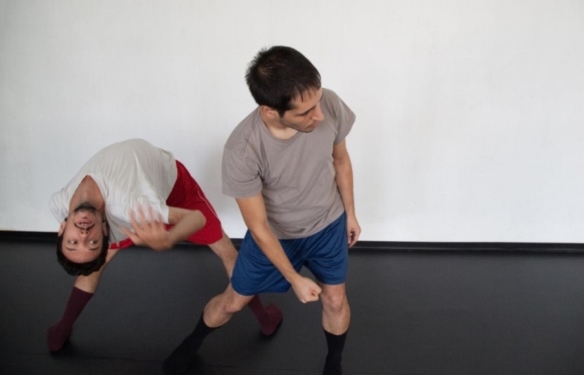
Scarabeo – Angles and the Void by Andrea Costanzo Martini, performed by Martini and Avidan Ben Giat, was a delight. The two are excellent performers, and performance itself is the focus here, in fascinating and funny variations. Every subtle difference in gesture alters its meaning, as extroverted exuberance turns to creative combat and back. Ballet, twerking, Vegas-worthy cavorting, Foley effects, evocations of Frankenstein, glittering angled lines, and an enthusiastic deconstruction of body and movement inform this work, suffused with joyous wild imagination.

